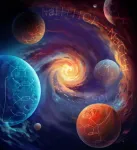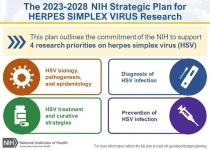(Press-News.org)
A new study shows the isolation and sequencing of more than a century-old RNA molecules from a Tasmanian tiger specimen preserved at room temperature in a museum collection. This resulted in the reconstruction of skin and skeletal muscle transcriptomes from an extinct species for the first time. The researchers note that their findings have relevant implications for international efforts to resurrect extinct species, including both the Tasmanian tiger and the woolly mammoth, as well as for studying pandemic RNA viruses.
The Tasmanian tiger, also known as the thylacine, was a remarkable apex carnivorous marsupial that was once distributed all across the Australian continent and the island of Tasmania. This extraordinary species found its final demise after European colonization, when it was declared as an agricultural pest and a bounty of £1 per each full-grown animal killed was set by 1888. The last known living Tasmanian tiger died in captivity in 1936 at the Beaumaris Zoo in Hobart, Tasmania.
Recent efforts in de-extinction have focused on the Tasmanian tiger, as its natural habitat in Tasmania is still mostly preserved, and its reintroduction could help recovering past ecosystem equilibriums lost after its final disappearance. However, reconstructing a functional living Tasmanian tiger not only requires a comprehensive knowledge of its genome (DNA) but also of tissue-specific gene expression dynamics and how gene regulation worked, which are only attainable by studying its transcriptome (RNA).
“Resurrecting the Tasmanian tiger or the woolly mammoth is not a trivial task, and will require a deep knowledge of both the genome and transcriptome regulation of such renowned species, something that only now is starting to be revealed”, says Emilio Mármol, the lead author of a study recently published in the Genome Research journal by researchers at SciLifeLab in collaboration with the Centre for Palaeogenetics*, a joint venture between the Swedish Museum of Natural History and Stockholm University.
RNA molecules recovered from the Tasmanian tiger
The researchers behind this study have sequenced, for the first time, the transcriptome of the skin and skeletal muscle tissues from a 130-year-old desiccated Tasmanian tiger specimen preserved at room temperature in the Swedish Museum of Natural History in Stockholm. This led to the identification of tissue-specific gene expression signatures that resemble those from living extant marsupial and placental mammals.
The recovered transcriptomes were of such good quality that it was possible to identify muscle- and skin-specific protein coding RNAs, and led to the annotation of missing ribosomal RNA and microRNA genes, the later following MirGeneDB recommendations.
“This is the first time that we have had a glimpse into the existence of thylacine-specific regulatory genes, such as microRNAs, that got extinct more than one century ago”, says Marc R. Friedländer, Associate Professor at the Department of Molecular Biosciences, The Wenner-Gren Institute at Stockholm University and SciLifeLab.
This pioneering study opens up new exciting opportunities and implications for exploring the vast collections of specimens and tissues stored at museums across the globe, where RNA molecules might await to be uncovered and sequenced.
“In the future, we may be able to recover RNA not only from extinct animals, but also RNA virus genomes such as SARS-CoV2 and their evolutionary precursors from the skins of bats and other host organisms held in museum collections”, says Love Dalén, Professor of evolutionary genomics at Stockholm University and the Centre for Palaeogenetics.
The authors of the study say they are excited for future holistic research developments integrating both genomics and transcriptomics towards a new era in palaeogenetics beyond DNA.
Read article in Genome Research
Contact details:
Emilio Mármol-Sánchez, Bioinformatician in Applied Biomedicine at DDLS Data Science Node, National Bioinformatics Infrastructure Sweden, Karolinska Institutet
Phone +46 79 01 59 771, e-mail emilio.marmol@scilifelab.se
Marc R. Friedländer, Associate Professor at the Department of Molecular Biosciences, The Wenner-Gren Institutet at Stockholm University and Science for Life Laboratory,
Phone +46 73 71 21 558, e-mail marc.friedlander@scilifelab.se
Love Dalén, Professor of Evolutionary Genomics, Centre for Palaeogenetics, Stockholm University
Phone +46 70 77 72 794, e-mail love.dalen@zoologi.su.se
* The Centre for Palaeogenetics (CPG) is a joint venture between the Swedish Museum of Natural History and Stockholm University. The overall objective of the centre is to bring researchers from different disciplines, such as biology, archaeology and geology, together into a state-of-the-art research environment dedicated to ancient DNA analyses.
about CPG
END
Life on a faraway planet — if it’s out there — might not look anything like life on Earth. But there are only so many chemical ingredients in the universe’s pantry, and only so many ways to mix them. A team led by scientists at the University of Wisconsin–Madison has exploited those limitations to write a cookbook of hundreds of chemical recipes with the potential to give rise to life.
Their ingredient list could focus the search for life elsewhere in the universe by pointing out the most likely conditions — planetary versions of mixing techniques, oven temperatures and baking times — for the recipes to come together.
The process ...
Millions of women are turning to the social media platform TikTok for health advice related to gynecologic cancers, but the majority of that information is misleading or dramatically inaccurate, according to a new study published by The Ohio State University Comprehensive Cancer Center – Arthur G. James Cancer Hospital and Richard J. Solove Research Institute in the journal Gynecologic Oncology.
Senior study author Laura Chambers, DO, says this highlights the power of social media to feed misinformation that could be ...
Alexandria, Virginia — The latest research and advances in otolaryngology-head and neck surgery will be presented in Nashville, Tennessee, during the AAO-HNSF 2023 Annual Meeting & OTO Experience, September 30 – October 4. From among the hundreds of research presentations submitted for the 2023 Annual Meeting, the Annual Meeting Program Committee (AMPC), comprised of physician members, selected 16 Scientific Oral Presentations as the Best of Orals, as well as an additional 40 Late-Breaking abstract submissions that were added to the Scientific Oral Presentation program to offer the latest and most ...
Researchers at the Tufts Lyme Disease Initiative recently received grants totaling more than $7 million to build on an already impressive array of discoveries that Tufts’ teams have made to combat tick-borne diseases.
While Lyme disease can often be successfully treated with antibiotics, 10-20% of patients experience persistent fatigue, joint pain, and mental impairments that last months or years. For some, it is never clear whether symptoms signal persistent infection, reinfection, or malfunction by the body’s immune system.
Researchers ...
Researchers in the University of Delaware College of Health Sciences Department of Medical and Molecular Sciences are playing a pivotal role on the global health stage as they investigate the most common sexually transmitted infection (STI) in the world.
Centers for Disease Control statistics show that 79 million Americans have human papillomavirus (HPV). With 14 million new infections each year, 80% of women will get at least one type of HPV at some point in their lifetime, according to the Office on Women’s ...
WHAT:
In response to the persistent health challenges of herpes simplex virus 1 (HSV-1) and HSV-2, today the National Institutes of Health released the Strategic Plan for Herpes Simplex Virus Research. An NIH-wide HSV Working Group developed the plan, informed by feedback from more than 100 representatives of the research and advocacy communities and interested public stakeholders. The plan outlines an HSV research framework with four strategic priorities: improving fundamental knowledge of HSV biology, pathogenesis, and epidemiology; accelerating research to improve HSV diagnosis; improving strategies to treat HSV while seeking a curative therapeutic; and, advancing research ...
Findings from a nationwide, multicenter study led by Johns Hopkins Medicine and the Johns Hopkins Bloomberg School of Public Health suggest that patients with COVID-19 have less chance of developing post-COVID conditions — commonly known as long COVID — if they receive early treatment with plasma from convalescent (recovered) COVID patients that contain antibodies against SARS-CoV-2, the virus that causes COVID-19.
The new research, first posted online today in mBio, a journal from the American Society for Microbiology, is a follow-up investigation to the 2021 clinical trial that showed convalescent plasma ...
Biomedical research aimed at improving human health is particularly reliant on publicly funded basic science, according to a new analysis boosted by artificial intelligence.
“What we found is that even though research funded by the National Institutes of Health makes up 10% of published scientific literature, those published papers account for about 30% of the substantive research — the important contributions supporting even more new scientific findings — cited by further clinical research ...
Using engineered microbes as microscopic factories has given the world steady sources of life-saving drugs, revolutionized the food industry, and allowed us to make sustainable versions of valuable chemicals previously made from petroleum.
But behind each biomanufactured product on the market today is the investment of years of work and many millions of dollars in research and development funding. Berkeley Lab scientists want to help the burgeoning industry reach new heights by accelerating and streamlining the process of engineering microbes to produce important compounds with ...
There is a widening health disparity among Black, American Indian and Alaska Native adults exposed to gun violence, according to Rutgers researchers who say these communities have more mental and physical health issues because they witness or are victimized at a higher rate.
In a new study published in Health Affairs Scholar, 3,015 Black and 527 American Indian/Alaska Native (AI/AN) adults residing in the United States were surveyed between April and May 2023.
Participants were asked whether they were threatened with a firearm, shot with a firearm, had a family or friend shot with a firearm, or witnessed or heard about a shooting. The results found that these ...








